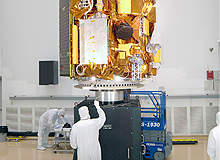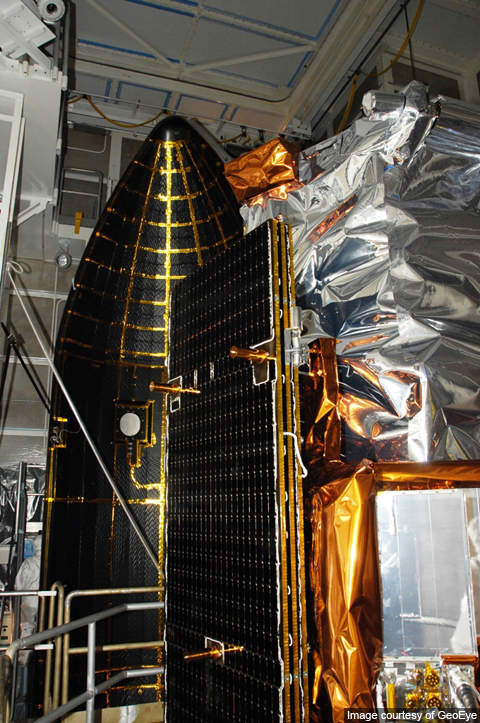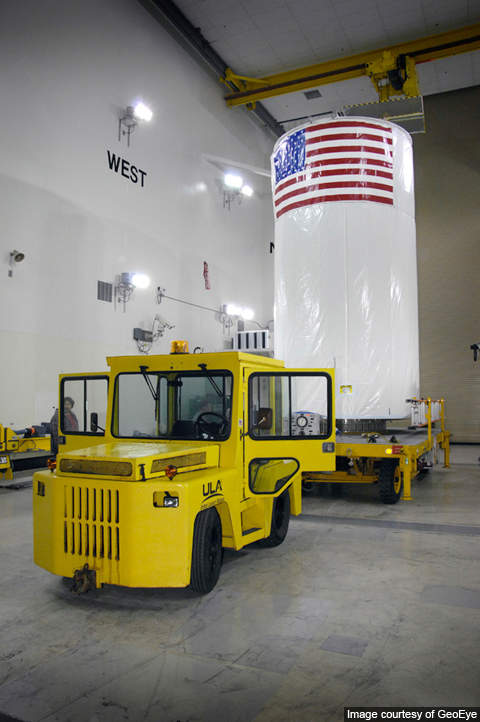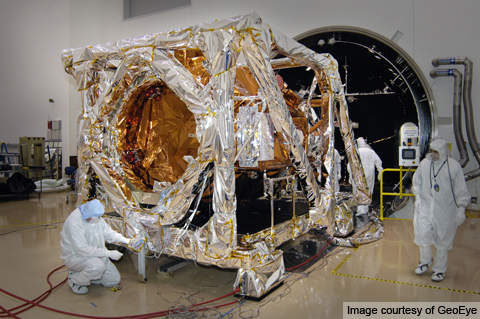The GeoEye-1 (formerly known as OrbView-5) is an earth observation satellite (EOS) designed and manufactured by General Dynamics Advanced Information Systems (GDAIS) in Gilbert, Arizona, US.
Owned and operated by GeoEye, the next-generation spacecraft renders high-resolution images of the earth for civilian and military applications.
The satellite was launched into orbit on the piggyback of Boeing Delta II launch vehicle on 6 September 2008. It was released into sun-synchronous orbit 58 minutes after lift-off from Vandenberg Air Force Base, California. It operates at an altitude of 681km above the Earth with an inclination of 98° for a maximum of 98 minutes of orbital period.
GeoEye-1 mission
GeoEye-1 offers high-resolution imagery to execute online mapping, defence, National Homeland and Security, agriculture, air and marine transportation, oil and gas, mining, energy and natural resources, and environmental supervising missions.
The satellite was launched under the National Geospatial-Intelligence Agency’s (NGA) NextView programme which was launched to procure high-resolution satellite imagery. It renders exact and relevant geospatial intelligence information to NGA for national security.
Google is the second major partner to access the GeoEye-1 imagery through GeoEye Archives. Both NGA and Google sponsored $502m in September 2004 to develop and launch the spacecraft within four years.
Design
The GeoEye-1 was designed for a lifespan of seven years. It weighs around 1,995kg at launch and consumes 3.2kW of power. Designed to rotate with an orbital velocity of 7.5km/sec, the spacecraft accomplishes 12 to 13 orbits a day. It can revisit any geographic location on the earth for every three days.
The spacecraft captures images with a ground resolution that is two times better than conventional imaging systems. It can capture imagery of up to 700,000km² area a day with a ground resolution of 0.41m in panchromatic mode. In multispectral mode, the satellite gathers 350,000km² of imagery a day with a ground resolution of 1.65m.
Development
ORBIMAGE signed an agreement with NGA in September 2004 to develop next generation Orbview-5 EOS which was renamed as GeoEye-1 upon the merger of ORBIMAGE and Space Imaging to form a new company named GeoEye.
GeoEye awarded a $209m contract to General Dynamics C4 systems in December 2004 to design and manufacture the GeoEye-1 spacecraft.
The environmental testing of GeoEye-1 was completed in April 2008. The satellite was scheduled for launch in April 2008 but delayed to August 2008. The launch date was postponed by a further month due to unavailability of the Big Crow telemetry relay aircraft.
The GeoEye-1 transmitted its first imagery of Kutztown University in Pennsylvania to GeoEye on 8 October 2008. NGA certified the satellite imagery as qualitative and accurate in February 2009. The operations of the GeoEye-1 were temporarily suspended in December 2009 due to constipation in the downlink antenna.
GeoEye is planning to launch the GeoEye-2 satellite in 2011 or 2012 to enhance the capacity of its forerunner, GeoEye-1.
Features
The GeoEye-1 features a very high resolution electro-optic panchromatic camera, star tracking sensors, GPS, gyros, 15.2km imaging swath, 1Tb recorder and 740Mbps X-band data downlink for improving communication between spacecraft and the ground station. It is also fitted with a 360° rotatable electro optic camera to capture imagery from all directions.
An optical telescope, detectors and high speed processing electronic payload are also installed in the spacecraft.
Launch vehicle
The Delta II was designed and built by Boeing Integrated Defence Systems. The vehicle can lift single, dual or multiple payloads simultaneously. It was assembled into two or three stage vehicles to conciliate wide range of mission requirements.
Ground station
The ground station is designed and manufactured by MacDonald, Dettwiler and Associates (MDA) and installed at the Herndon headquarters in Virginia.
Three additional ground stations were leased to Barrow, Alaska; Tromso, Norway; and Troll, Antarctica.
The satellite delivers large volume of data to four ground stations. The operational facility located at the City of Thornton in Colorado was also overhauled to utilise as a back-up ground station for the GeoEye-1. Communication between the control station and the spacecraft is enabled through a specific bandwidth assigned to the customer.








